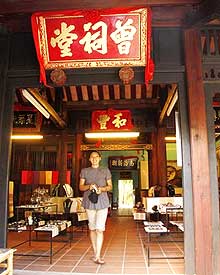 The Deputy Director of Hoi An Relics Preservation and Management Centre Nguyen Duc Minh told that the United Nations Educational, Scientific and Cultural Organisation (UNSECO) commended Vietnamese craftsmen on the chapel’s conservation as its traditional values have been kept in line with other preserved sites in the ancient city.
The Deputy Director of Hoi An Relics Preservation and Management Centre Nguyen Duc Minh told that the United Nations Educational, Scientific and Cultural Organisation (UNSECO) commended Vietnamese craftsmen on the chapel’s conservation as its traditional values have been kept in line with other preserved sites in the ancient city.The chapel was restored at a cost of more than VND 537 million, of which 605 was provided by Hoi An’s local authority.
“The restoration project demonstrates the commendable commitment by private individuals to cooperate with the local authorities in the conservation of a World Heritage property. As one of Hoi An’s key landmarks, the newly-refurbished chapel now stands out as living landmark in the heritage city, serving clan members, the local population and visitors alike,” said UNESCO about the chapel.
Located about 50m from the japanese Covered Bridge in Hoi An City, the Tang Family Chapel is typical of 18th and 19th -century overseas Chinese clan halls, with a succession of smaller entry halls leading to a large central hall for worshipping ancestors.
The chapel is now still in use by the Tang Clan as a place of worship, while also serving as a tourist attraction.
This year, UNESCO granted 13 awards to cultural heritage conservation projects in the Asia-Pacific region, including three awards of distinction, four awards of merit, four honourable mentions and the jury’s commendation for innovation.
This is the third time Vietnam has received a UNESCO award for this reason. Vietnam took the award for excellence for the Hoi An preservation project in 2000 and the award of merit for a project to preserve the architecture of six old traditional Vietnamese houses.